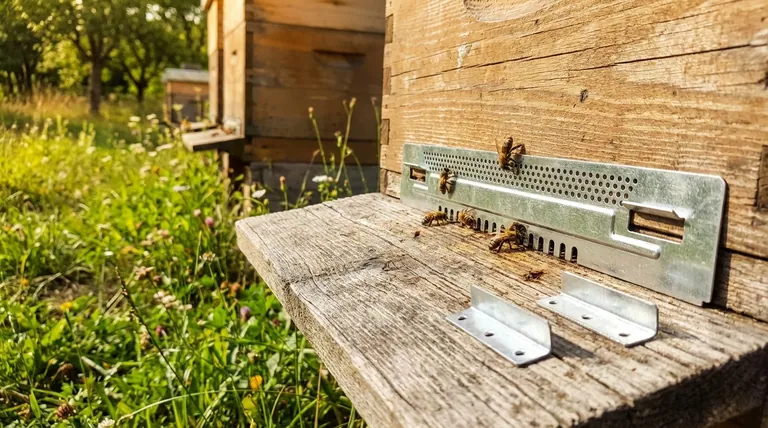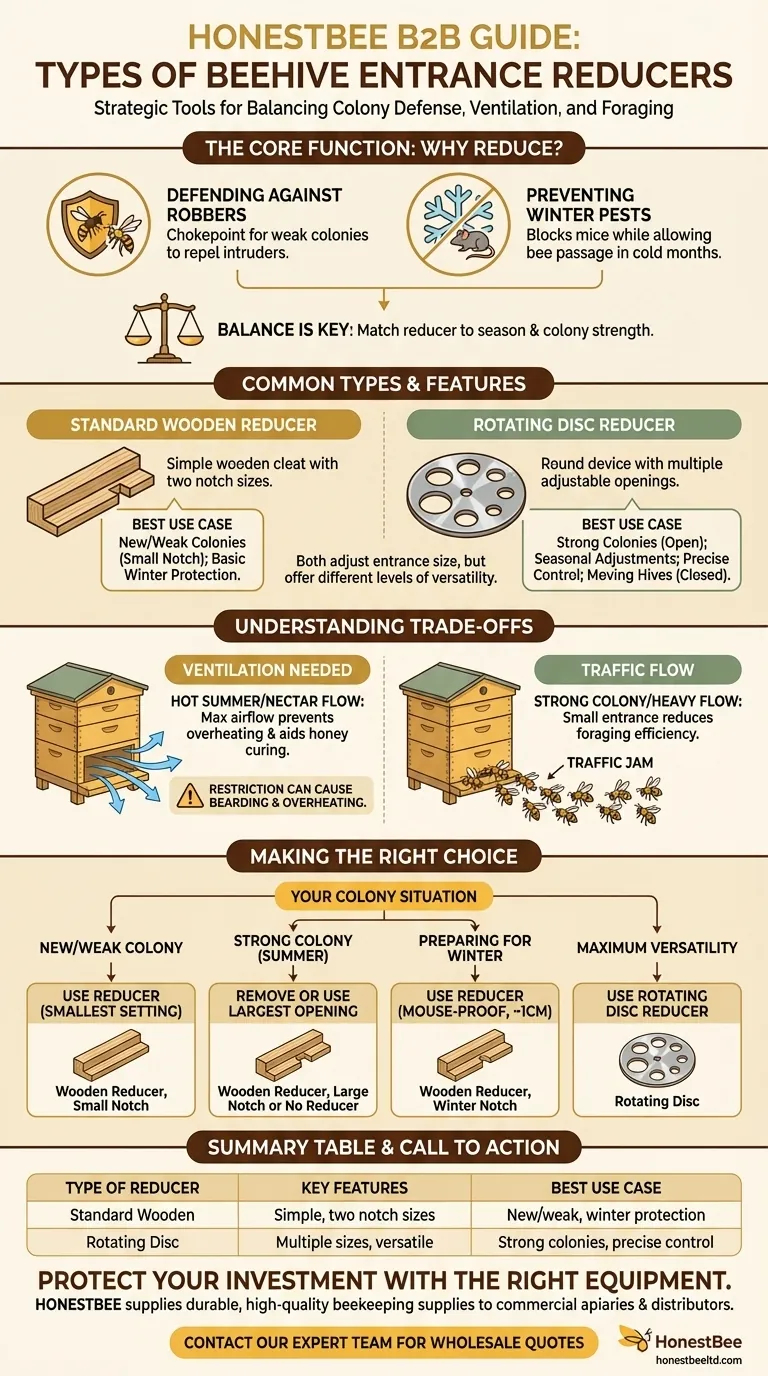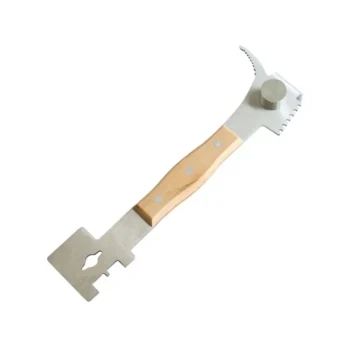The primary types of beehive entrance reducers are the simple wooden bar reducer and the multi-function rotating disc reducer. While they can be made from wood, plastic, or metal, their core function is to adjust the size of the hive entrance to match the colony's ability to defend itself.
The purpose of an entrance reducer isn't just to block an opening; it's a strategic tool to balance a colony's defensive needs against its requirements for ventilation and foraging traffic. The right choice depends entirely on the season and the strength of your specific colony.

The Core Function: Why Reduce the Entrance?
An entrance reducer is a simple piece of equipment that makes the hive's main entrance smaller. This single function serves several critical purposes for the health and safety of the honey bee colony.
Defending Against Robbers
A small, new, or weak colony has fewer guard bees. A large, open entrance is a significant defensive liability, making the hive an easy target for robbing bees from stronger hives or predatory wasps.
By reducing the entrance, you create a smaller, more manageable chokepoint. This allows the colony's limited number of guard bees to effectively defend their home against intruders.
Preventing Winter Pests
During the cold months, mice and other small rodents seek warm, sheltered places to nest. A beehive, with its stored honey and warmth from the winter cluster, is an ideal target.
A reducer with a notch small enough to block mice but large enough for bees to pass is essential winter equipment. It prevents an infestation that can destroy comb and contaminate the hive.
Common Types of Entrance Reducers
While the goal is the same, reducers come in two main designs, each with its own advantages.
The Standard Wooden Reducer
This is the most common type of reducer. It is a simple rectangular wooden cleat cut to fit the width of the hive entrance.
It typically features two different-sized notches. You can flip the bar to expose either the larger opening for a moderately-sized colony or the smaller opening for a very new or weak colony.
One common critique is that the smallest notch on many commercially produced reducers is often too small for practical use, but they remain a simple and effective tool.
The Rotating Disc Reducer
This is a round device, often made of plastic or metal, that fits over a drilled hole in the hive body or on a dedicated entrance block.
The disc has several openings of different sizes and can be rotated to select the desired entrance. Options often range from fully open to fully closed (for moving a hive), to a queen excluder setting, to a very small opening for just one or two bees. This design offers the most versatility.
Understanding the Trade-offs
Using an entrance reducer is not without its downsides. A beekeeper must weigh the defensive benefits against the potential for creating other problems.
The Need for Airflow
Bees work constantly to regulate the hive's internal temperature and humidity. A wide-open entrance is crucial for ventilation, especially during hot summer months and when bees are curing nectar into honey.
Restricting the entrance too much can lead to overheating and inhibit the honey-curing process. It can also cause "bearding," where a large number of bees cluster on the outside of the hive to cool down.
The "Traffic Jam" Problem
For a strong, thriving colony during a heavy nectar flow, a small entrance creates a significant bottleneck. Foraging bees get stuck in a traffic jam trying to get in and out, reducing the overall efficiency of the colony.
Letting the Bees Decide
It's important to observe the bees' natural behavior. When bees feel their entrance is too large for their defensive needs, they will often use propolis (a resinous bee glue) to build their own reducer, customizing the entrance to their exact preference.
Making the Right Choice for Your Colony
Choosing and using an entrance reducer effectively is a matter of adapting to your colony's specific situation.
- If your primary focus is establishing a new or weak colony: Use a reducer on its smallest practical setting to give the bees a defensible entrance against robbers.
- If your primary focus is managing a strong colony in summer: Remove the reducer entirely or use the largest possible opening to maximize ventilation and prevent foraging traffic jams.
- If your primary focus is preparing for winter: Use a reducer with an opening large enough for bees but small enough to block mice (typically around 3/8 inch or 1 cm).
- If your primary focus is maximum versatility: A rotating disc reducer provides the widest range of options for nearly any situation you will encounter.
Ultimately, an entrance reducer is a tool that helps you support the colony until it is strong enough to manage its own defense and environment.
Summary Table:
| Type of Reducer | Key Features | Best Use Case |
|---|---|---|
| Standard Wooden Reducer | Simple cleat with two notch sizes; affordable and common. | New/weak colonies; basic winter protection. |
| Rotating Disc Reducer | Multiple opening sizes; offers maximum versatility. | Strong colonies; seasonal adjustments; precise control. |
Protect your investment and support your colonies with the right equipment. HONESTBEE supplies durable, high-quality beekeeping supplies and equipment to commercial apiaries and beekeeping equipment distributors through wholesale-focused operations. Let us help you choose the right entrance reducer for your specific needs. Contact our expert team today to discuss your requirements and request a wholesale quote.
Visual Guide

Related Products
- Beehive Entrance Reducer Guardian Metal Hive Entrance for Bees
- Multi-Functional Sliding Hive Entrance for Beekeeping
- Multi-Functional Rotary Hive Entrance Disc for Beekeeping
- Beehive Entrance Discs Plastic Bee Entrance Disc for Bee Hives
- Multi-Function Hive Tool with Integrated Hammer for Beekeeping
People Also Ask
- What size is the entrance hole in a native bee hive? The 13mm Standard for a Thriving Colony
- What are the features of the side with oblong holes in the entrance reducer? A Guide to Hive Defense & Health
- How big should a beehive entrance be? Optimize for Colony Health & Honey Production
- What are the different entrance sizes for an 8 or 10-frame Langstroth hive? A Guide to Seasonal Management
- How can a Langstroth hive entrance be adjusted? Mimic Natural Bee Preferences for a Healthier Hive



















